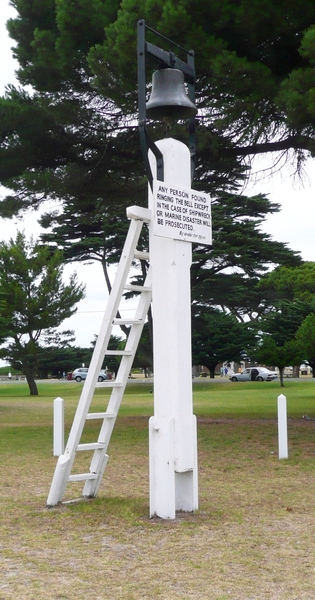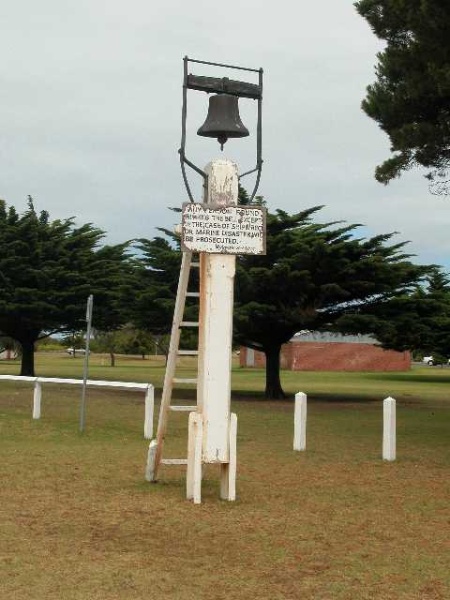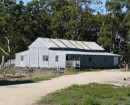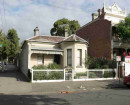WRECK BELL
PRINCES PARK, CNR WHARF STREET AND GELLIBRAND STREET QUEENSCLIFF, QUEENSCLIFFE BOROUGH
-
Add to tour
You must log in to do that.
-
Share
-
Shortlist place
You must log in to do that.
- Download report




Statement of Significance
What is significant?
The Wreck Bell was a facility provided by the Ports and Harbours Branch to summon the crew of the Queenscliff lifeboat in times of a maritime disaster. The bell was cast by John Danks & Son, Melbourne, and the supporting structure erected by William Golightly (Jnr) in September 1891. It was placed in Lower Princess Park close to the residences of the fishermen who generally formed the crew of the lifeboat. The head of the lighthouse service was automatically the lifeboat's coxswain. When the lifeboat was required for assistance in a maritime emergency such as a search and rescue involving a shipwreck, the bell was rung to alert the voluntary crew. Prior to 1891, analarm bell mounted on the Signal Mastat Shortland Bluff was rung by the Signal Master to call out the lifeboat crew.
The Wreck Bell was used to call the crew on many occasions, the last being in 1974 when they were called out to a fire on the vessel Brisbane Trader.
There was also another wreck bell called the "Distress Bell", which was once located at the corner of Ocean Amphitheatre and Portsea Roads in 1965 but has since disappeared.The bell, still in its original location, is mounted on a two metre high square timber post, which is supported and bolted to two upright rectangular timbers embedded into a rectangular platform base. At the top of the post, a bifurcated yoke belfry surrounds the bell. Below this, attached to the post on the western side, is a sign which reads "Any person found ringing this bell except in the case of shipwreck or maritime disaster will be prosecuted". The bifurcated yoke structure housing the Wreck Bell, along with the bell, platform base, and ladder are original.
How is it significant?
The Wreck Bell is of historical and social significance to the State of Victoria.
Why is it significant?
The Wreck Bell is of historical significance for its associations with the maritime history of Victoria. As an essential maritime facility involved in many shipping emergencies, the bell reflects the historical development of the port of Melbourne and the level of its shipping activity. The bell was rung every time the lifeboat was used for a major shipwreck in the Port Phillip Heads area from 1894 to 1974. Many of these wrecks were of interstate and international origins.
The Wreck Bell is of historical significance as one of only two extant wreck bells in Victoria. The other wreck bell, located at Lakes Entrance and built in 1881, is of a different construction method. The Queenscliff bell is the only example of a wreck bell with a bifurcated yoke structure in the state, the only other example known to have existed was erected at Port Fairy in 1884.
The Wreck Bell has social significance to the local community, especially the fishing community, many of whom can demonstrate generations of family members serving as the lifeboat crew.
-
-
WRECK BELL - History
The Wreck Bell was used to summon the crew of the Queenscliff lifeboat in times of a maritime disaster. The bell was a facility provided by the Ports and Harbour of the Public Works Department. The bell was supplied by John Danks & Son, Melbourne, and the supporting structure erected by William Golightly (Jnr) in September 1891. The bell was only ever rung (by the lighthouse keeper or coxswain) in the event of a maritime emergency involving a wreck where the lifeboat was required, and was not used for a call-out, where emergency assistance such as a search and rescue was required (Boyd, 1996:12, 13). When the bell was rung, (which had a distinctive tone), all the voluntary lifeboat crew dropped whatever they were doing and ran to the lifeboat shed. The bell was used for the first time when the ketch W. J. Taylor was wrecked on Point Lonsdale Reef on 26 December 1894, and was last used when the lifeboat was called out to the fire on the vessel Brisbane Trader in 1974 (Boyd, 1996: 5; Syme, 2001: 39, 40).
Prior to 1891, an emergency signal bell was located in the Signal Station at Shortland Bluff, and was used to alert the community in times of fire and shipwrecks (Dod, 1931).
The Wreck Bell was placed near the bottom of town, close to the Esplanade Hotel (in the reserve on the eastern corner of Gellibrand and Wharf Street) as the fishermen were almost always the crew and this was close to their residences. The head of the lighthouse service was automatically the coxswain (Syme, 2001: 39; Cec Anderson/ Les Irving-Dusting pers comms).
The process for launching the lifeboat was as follows:
"The alarm bell was rung, and everyone would meet at the (lifeboat) shed,
everyone could hear the bell in the fisherman’s flat.. no pilots crews were involved in the rescues, as they were ashore (and therefore) they couldn’t be on the lifeboat (Beazley, pers comms).
The only other recorded instance of the ringing of the wreck bell outside of a shipwreck was when Australian Prime Minister Harold Holt went missing at Portsea back Beach in 1967 (Boyd, 1996:25).
There was also another wreck bell called the "Distress Bell", which was once located at the corner of Ocean Amphitheatre and Portsea Roads in 1965(The Nepean Historical Society, 1966:63), but has since disappeared.
The Bell is mounted on a two metre high square timber post, which is supported and bolted to two upright rectangular timbers embedded into a rectangular platform base (possibly made of concrete). At the top of the post, a bifurcated yoke belfry surrounds the bell. Below this attached to the post on the western side is a sign which reads " Any person found ringing this bell except in the case of shipwreck or maritime disaster will be prosecuted".
Interpretation
The bifurcated yoke structure housing the Wreck Bell, along with the bell, platform base, and ladder are original. The timber yoke pillars surrounding the bell and the sign are showing signs of wear, but the post, ladder and platform base are in good condition (Symes, pers comms).
The wreck bell, which still stands in it original location, has been rung every time the lifeboat was used for a major shipwreck in the Port Phillip Heads area since 1891. Many of these wrecks were of interstate and international origins. This facility is of state significance due to its association with multiple shipping tragedies, and as an essential maritime facility associated with the historical development of the port of Melbourne. It also has national significance for its links to the disappearance of Harold Holt and the subsequent rescue. The feature has social significance to the local community, especially the fishing community, many of whom can demonstrate generations of family members acting as the lifeboat crew. The bell has local significance as an intrinsic and aesthetic component of the local maritime landscape, and has strong associations to other landscape features in the region relating to disasters and rescue events including: The Queenscliff Pier, Queenscliff Lifeboat and Lifeboat Shed, The Queenscliff Maritime Centre - QMC (formerly the Queenscliff Lifeboat Preservation Society), The Point Lonsdale Pier and Point Lonsdale Lifeboat (now at the QMC), the Point Lonsdale and Pt Nepean Rocket Sheds, Shortland Bluff Signal Station, and shipwrecks in the Port Phillip Heads area. The provenance of the bell is highly significant, due to its proximity to the former lifeboat shed and the former crew members in the community (i.e. the fishermen).
Lifesaving and the pilot’s service were two of the most essential services based at Queenscliff, and were responsible in part for the development of Queenscliff as a maritime service town.
The Wreck Bell is the only example of an extant bifurcated yoke wreck bell facility left in the state, was only one of two examples known to have existed (the other was previously located at Port Fairy in 1884). It is also one of only two extant wreck bells state-wide, with another extant wreck bell of different construction at Lakes Entrance that was built in 1881 (Symes, pers comms). This site is also a significant example of the wider resource of lifesaving and maritime infrastructure heritage from around the state.
Sources
Boyd, Betty, 1996, Diary of a Lifeboat and Other Small Craft, Queenscliff: Private Publication - G.T Roddick
Dod, Henry Charles, 1931, Early Memories of Queenscliff, Geo. A. List Hickie
Syme, Martin, A., 2001, Lifeboats in Victoria: The Story of Lifeboats and Their Crews in Victoria 1856- 1979, Roebuck Society Publications
The Nepean Historical Society, 1966, The Peninsula Story: Sorrento and Portsea – Yesterday, Auburn: Crusader Printing.
Anderson, Cecil, Volunteer, Queenscliff Historical Society, Personal Communications 2002
Beazley, John, Volunteer, Queenscliff Maritime Centre, Personal Communications 2001
Irving-Dusting, Les, President, Queenscliff Maritime Centre, Personal Communications 2002/ 2003
Syme, Martin, Personal Communications 2004
WRECK BELL - Permit Exemptions
General Exemptions:General exemptions apply to all places and objects included in the Victorian Heritage Register (VHR). General exemptions have been designed to allow everyday activities, maintenance and changes to your property, which don’t harm its cultural heritage significance, to proceed without the need to obtain approvals under the Heritage Act 2017.Places of worship: In some circumstances, you can alter a place of worship to accommodate religious practices without a permit, but you must notify the Executive Director of Heritage Victoria before you start the works or activities at least 20 business days before the works or activities are to commence.Subdivision/consolidation: Permit exemptions exist for some subdivisions and consolidations. If the subdivision or consolidation is in accordance with a planning permit granted under Part 4 of the Planning and Environment Act 1987 and the application for the planning permit was referred to the Executive Director of Heritage Victoria as a determining referral authority, a permit is not required.Specific exemptions may also apply to your registered place or object. If applicable, these are listed below. Specific exemptions are tailored to the conservation and management needs of an individual registered place or object and set out works and activities that are exempt from the requirements of a permit. Specific exemptions prevail if they conflict with general exemptions. Find out more about heritage permit exemptions here.Specific Exemptions:General Conditions: 1. All exempted alterations are to be planned and carried out in a manner which prevents damage to the fabric of the registered place or object. General Conditions: 2. Should it become apparent during further inspection or the carrying out of works that original or previously hidden or inaccessible details of the place or object are revealed which relate to the significance of the place or object, then the exemption covering such works shall cease and the Executive Director shall be notified as soon as possible. General Conditions: 3. If there is a conservation policy and plan approved by the Executive Director, all works shall be in accordance with it. Note: The existence of a Conservation Management Plan or a Heritage Action Plan endorsed by Heritage Victoria provides guidance for the management of the heritage values associated with the site. It may not be necessary to obtain a heritage permit for certain works specified in the management plan. General Conditions: 4. Nothing in this declaration prevents the Executive Director from amending or rescinding all or any of the permit exemptions. General Conditions: 5. Nothing in this declaration exempts owners or their agents from the responsibility to seek relevant planning or building permits from the responsible authorities where applicable. Minor Works : Note: Any Minor Works that in the opinion of the Executive Director will not adversely affect the heritage significance of the place may be exempt from the permit requirements of the Heritage Act. A person proposing to undertake minor works may submit a proposal to the Executive Director. If the Executive Director is satisfied that the proposed works will not adversely affect the heritage values of the site, the applicant may be exempted from the requirement to obtain a heritage permit. If an applicant is uncertain whether a heritage permit is required, it is recommended that the permits co-ordinator be contacted.
· The process of gardening and maintenance within the extent of registered land.
· Repairs, conservation and maintenance to hard landscape elements within the extent of registered land, apart from the Wreck Bell, such as fences, roads and paths, drainage and irrigation system.
WRECK BELL - Permit Exemption Policy
The Wreck Bell is historically significant for its associations with the maritime history of Victoria, for its rarity and for its location. The purpose of the permit exemptions is to allow works that do not impact on the significance of the Wreck Bell to occur without the need for a permit. Alterations that impact on the significance of the Wreck Bell are subject to permit applications. Any restoration of the Bell should be carried out after consultation with Heritage Victoria.
-
-
-
-
-
LATHAMSTOWE
 Victorian Heritage Register H1052
Victorian Heritage Register H1052 -
PILOTS COTTAGES
 Victorian Heritage Register H1618
Victorian Heritage Register H1618 -
ROSENFELD
 Victorian Heritage Register H1134
Victorian Heritage Register H1134
-
"1890"
 Yarra City
Yarra City -
'BRAESIDE'
 Boroondara City
Boroondara City -
'ELAINE'
 Boroondara City
Boroondara City
-
-












